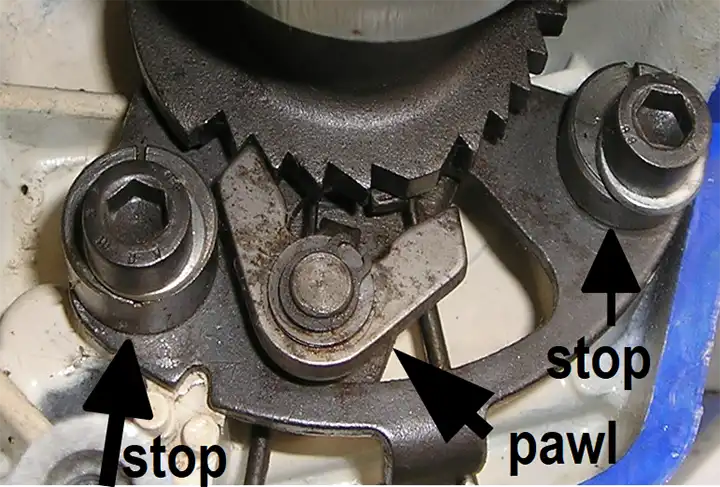Sachs and Your Left Foot 101
by Doug Wilford
Originally printed in the 2007 issue #34 of Still….Keeping Track
Thirty-nine years ago V-001 rolled off the assembly line. Would you believe the topic about the Sachs shifting problems has not changed in that many years. Considering all the modifications and changes made inside the Sachs transmission. I still hear the same bad mouth. Kind of like the 250 pound 125cc rider that says: “I need more power”. Just maybe, there is a solution other than mechanical.
The statement of: “It is impossible to miss a shift” is correct when done properly, if adjusted properly and the selector key is not worn out. Sachs, Zundapp and some others use what is called a “Draw Key” shifting mechanism.
Draw Key: All the gears in the transmission are in a constant mesh with each other. The main shaft has the sprocket attached to one end. The gears on the main shaft are free and spinning on the main shaft. Inside the main shaft is the selector rod, which has the selector key attached, when shifted, the key moves from one gear to the other locking the engaged gear to the main shaft and the (Christmas Tree) lay shaft.

The lay shaft has the clutch hub attached. Adjustment is made to the keys position by using the selector assembly. If properly adjusted, the key cannot go any farther in or out of the gear it is lined up with. The selector rod has detent grooves that help locate the key for perfect alignment. The “Draw Key”, “Key”, or selector key is what you control with your foot on or under the shift lever.

Most other motorcycles use a “Drum” or Fork shifting system. Remember now, these are two different shifting systems. This makes two different ways to properly shift gears. German engineering makes the draw key act more like an old BMW (Push down or Pull up) where you hold the shift lever against the stop until the gear is engaged.

Most of us have ridden Japanese bikes that rarely miss a shift no matter how you operate the shift lever. Stomp on it, tap it, whatever, and you get the gear you are after.
You cannot under any circumstance tap or stomp the Sachs shift lever and expect the Draw Key shifter to work properly. By holding the shift lever against the up or down stop, it cannot go between gears and stay there. This is why you miss far fewer gears up shifting than down shifting. It takes practice to fan the shift lever up, compared to tapping or fanning it on a down shift. Most of the time you will miss, going down from 3rd to 2nd, ending up in neutral. How can this happen? Neutral is beyond second, in between 1st and 2nd.
Experience is a great teacher. After many hours repairing transmissions on the work bench and many hours in the saddle, I learned that when you stomp, tap or fan the lever down, the selector key has a tendency to fly or go right thru the lower gear you were after. This is the easiest, biggest and most often misuse to the Draw Key system. Try it in practice. Educate your left foot. Shift positive. Hold the lever against the stop! YOU MUST HOLD THE SHIFT LEVER AGAINST THE STOP!


Break the habit, educate your left foot, think Penton and most of all, “Have Fun.”
Foot Note: For the proper length of shift lever: a bigger foot = a longer lever. The length of the lever controls the distance you have to move the lever up or down.


